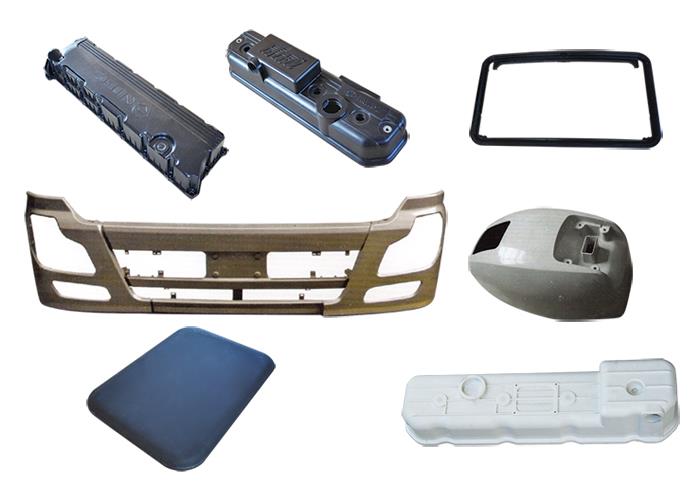Sheet molding compound refers to unsaturated polyester resin as the main body, adding curing agent, mold release agent, filler, low shrinkage agent, thickener, etc. Molding compound covered with polyethylene (PE) film. This paper mainly briefly describes the composition and classification application of SMC.
Sheet Molding Compound’s Composition
SMC is composed of unsaturated polyester resin, crosslinking agent, initiator, filler, thickener, release agent, glass fiber, and polymerization inhibitor. Among them, the first four categories mainly provide the material framework for products and increase strength. The last four categories are mainly for the properties of increased viscosity, corrosion resistance, insulation, and structural stability of the product.
1. Unsaturated polyester resin and crosslinking agents are the main body of SMC. Unsaturated polyester resins are usually polycondensed from unsaturated dicarboxylic acids (or anhydrides), saturated dicarboxylic acids (or anhydrides), and polyols. It has certain mechanical properties and strength, and the internal force is uniform. The crosslinking agent is mainly styrene. After the two are cross-linked, they are the main materials for the curing plasticity of the product, which play the role of connection, support, transmission balance, and protection.
2. The initiator causes the resin and crosslinker to cure and form in the resin paste stage. Its function is mainly to make the resin and the double bond in the cross-linking monomer such as styrene copolymerize so that the SMC can be solidified and formed in the mold cavity.
3. The filler occupies more than one-third of the sheet molding compound and can adjust the viscosity of the molding compound. It generally needs to have the characteristics of low specific gravity, low oil adsorption value, fewer pores, corrosion resistance, and low cost. The commonly used filler components are mainly CaCO3, Al(OH)3, and so on.
4. Thickeners give SMC a high-viscosity, non-sticky property. The preparation of sheet and bulk molding compounds requires a low viscosity of the resin to facilitate the impregnation of the glass fiber and filler by the resin. And compression molding requires a higher viscosity. Therefore, it is necessary to add a thickener before the molding process to convert the low viscosity of glass fiber impregnation into a high viscosity that is not sticky.
5. The release agent prevents the sheet molding compound from having an affinity with the metal mold surface. The release agent can prevent the unsaturated polyester resin from interacting with the surface of the metal mold during the plastic process of the resin mixture. Mainly long-chain fatty acids or salts represented by zinc stearate. Excessive use will easily reduce the performance of the product. The general usage accounts for 1~3% of the total product to ensure the quality of the product.
6. Glass fibers can enhance the corrosion resistance and insulation properties of SMC. Sheet molding compound usually chooses chopped glass fiber mats as reinforcement material. Excessive use will easily make the product too fluffy, and the use of too small a dose will not have an obvious strengthening effect on the product. The general usage is about 20%. In this way, the product can simultaneously meet the two processes of extrusion molding and compression molding.
7. Inhibitor increases the stability of SMC and prolongs the storage period. Since the initiator styrene will decompose slowly, causing the polymerization of the resin, adding an appropriate amount of free radical scavenger (polymerization inhibitor) can slow down the speed of styrene decomposition and prolong its storage period. Inhibitors are usually benzoquinones and polyvalent phenolic compounds.
Application of Sheet Molding Compound Products
SMC has the advantages of excellent electrical performance, strong corrosion resistance, lightweight, easy and flexible engineering design, etc. Its mechanical properties are comparable to some metal materials. Therefore, it is widely used in eight fields such as the automobile industry, railway vehicles, construction, electrical appliances, and communications (Table 1).
Among them, in the early stage, it was mainly used in the form of insulating boards in the fields of construction, electrical appliances, and communications, and the technology is relatively mature. It was then used in the automobile industry to replace part of the steel and aluminum alloy materials of the body to reduce the weight of the car.
Under the background of the current energy saving and emission reduction and the development of new energy vehicles, the technology of automotive products continues to develop towards lightweight and high quality. Up to now, the application of SMC materials can be seen everywhere in daily life. It is reflected in wireless communications, explosion-proof electrical enclosures, ground insulation materials, bathrooms, and high-speed rail facilities.
Table 1 Eight major applications and subdivision fields of SMC materials
| NO | Field | Segmentation |
| 1 | Auto industry | Suspension parts, dashboards; body parts and components; under-hood parts |
| 2 | Railway vehicle | Window frames; Seats; Carriage panels and ceilings; Toilet components |
| 3 | Construction sector | Water tank; Bath products; Septic tank; Building formwork; Storage room components |
| 4 | Electrical Appliances and Communications | Electrical enclosures; electrical components and components (insulation tools) |
| 5 | Bathroom | Sink; Shower equipment; Overall bathroom; Sanitary components |
| 6 | Ground material | Anti-slip anti-static floor |
| 7 | Explosion-proof electrical enclosure | Explosion-proof electrical equipment shell products |
| 8 | Wireless communication | FRP reflector antenna, etc |
Summarize
The unsaturated polyester resin, crosslinking agent, initiator, and filler in the sheet molding compound provide a material framework for the product and increase the structural strength. Thickener, release agent, glass fiber, and polymerization inhibitor add viscosity, corrosion resistance, insulation, and structural stability to the product. Such products have been applied in eight major fields including the automobile industry and railway vehicles. Under the current background of energy conservation, environmental protection, and low energy consumption, the automotive industry has put forward higher and higher requirements for SMC materials due to their lightweight requirements. Which is the main driving force for the development of SMC technology.
Use the composite hydraulic press machine to press sheet molding compound products. Zhengxi is a professional hydraulic press factory in China, providing high-quality presses. Contact us to get details.
Post time: May-17-2023








